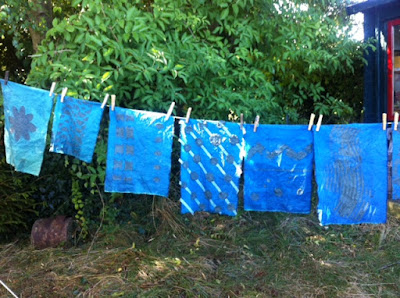It's nearly a week since my 'Wild textiles' workshop - 2 days of foraging and wild textile making with 5 other intrepid makers...
Sally and Geoff kindly lent us and even erected their party tent in our garden (very bake off) and we got started by foraging and collecting local plants, leaves, bark, mud, chalk... everything we might need for making colour, creating resists and dyeing cloth.
Together we filled our huge collection of pots and pans (sorry, Ursula but the seaweed went in the one you leant me) with our seasonal haul - hops, alder, ash, walnuts, willow, black berries, wayfarer tree, weld, dandelions, rhubarb, raspberry leaves amongst other things. And as we got the colours on the boil, delicious smells and enticing colours started ouzing out.
At this point we short circuited the electricity in David's writing hut - but redeployed our stoves and kept ongoing. We also mixed up a resist in the tradition of Indian dhabu printing using mud from our local River Adur and smashing up loads of chalk - which was hard work. We dyed our resists in indigo with lovely results.
By the afternoon of the second day we were totally on a roll - I was very impressed by everyone's meticulous record-keeping of their experiments with different mordants and afterbaths. Very different colour palettes emerged.
It was to be to be honest - a bit of an adventure... climbing chalk cliffs, slipping in mud, getting stung and ruining our hands our hands in the process - but the results were truly stunning.
I am now taking bookings for Spring Wild Textiles 2017 - a seasonal 2 day workshop based in the South Downs and all about the local colour we can forage and create for ourselves sustainably. So if you're interested in a South Downs adventure get in touch with me at dorapattern@gmail.com
The workshop costs £80 for 2 days with all materials included and you will learn how to make your own natural dyes using foraged plants, make mud resist patterns with indigo and experiment with a larger piece to take home with you.
The workshop costs £80 for 2 days with all materials included and you will learn how to make your own natural dyes using foraged plants, make mud resist patterns with indigo and experiment with a larger piece to take home with you.

























